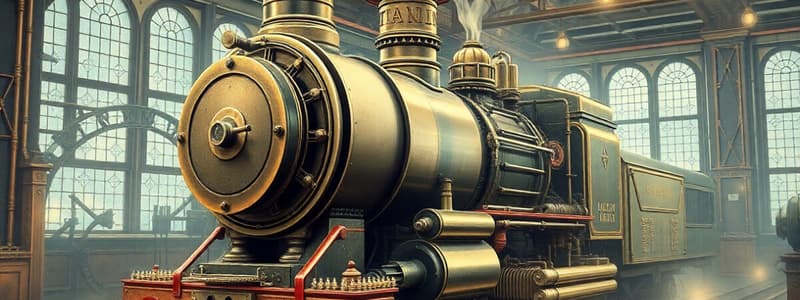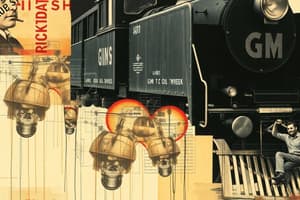Podcast
Questions and Answers
Which of the following is NOT a benefit of lubrication in engine systems?
Which of the following is NOT a benefit of lubrication in engine systems?
- Cooling of engine components
- Enhancement of fuel combustion efficiency (correct)
- Protection from wear and corrosion
- Prevention of carbon deposition
What is the pump discharge rate of the main lubricating oil system at 8th notch?
What is the pump discharge rate of the main lubricating oil system at 8th notch?
- 413 LPM
- 11 LPM
- 1703 LPM
- 867 LPM (correct)
What is the function of the soak back system in the GM locomotive lubrication system?
What is the function of the soak back system in the GM locomotive lubrication system?
- To increase overall oil temperature
- To cool the engine during operation
- To filter out contaminants from the oil
- To lubricate the turbocharger bearings post-shutdown (correct)
How is the pressure relief valve in the soak back system set, and what is its purpose?
How is the pressure relief valve in the soak back system set, and what is its purpose?
What characterizes the scavenging system in the GM locomotive lube oil system?
What characterizes the scavenging system in the GM locomotive lube oil system?
Which component is NOT contained in the same housing as the main lubricating oil pump?
Which component is NOT contained in the same housing as the main lubricating oil pump?
What ensures that the engine's safety and component lifespan depend on effective lubrication?
What ensures that the engine's safety and component lifespan depend on effective lubrication?
What is a primary function of the piston cooling oil system?
What is a primary function of the piston cooling oil system?
Which of the following describes a characteristic of the lube oil system in GM locomotives?
Which of the following describes a characteristic of the lube oil system in GM locomotives?
What is the purpose of the relief valve in the main lubricating oil system?
What is the purpose of the relief valve in the main lubricating oil system?
At what pressure will the by-pass valve in the oil filter activate?
At what pressure will the by-pass valve in the oil filter activate?
Which component directs oil to cool the underside of the piston crown?
Which component directs oil to cool the underside of the piston crown?
What happens when the crank-case pressure reaches a certain value?
What happens when the crank-case pressure reaches a certain value?
What is the minimum oil pressure at idle for the main lubricating oil system?
What is the minimum oil pressure at idle for the main lubricating oil system?
What does the Hot Oil Detector monitor to prevent engine damage?
What does the Hot Oil Detector monitor to prevent engine damage?
What is the function of the main lube oil pump?
What is the function of the main lube oil pump?
Which oil system shares a common suction with the main lube oil pump?
Which oil system shares a common suction with the main lube oil pump?
How does the engine protect itself in case of insufficient oil pressure?
How does the engine protect itself in case of insufficient oil pressure?
What does the main oil manifold extend along in the engine?
What does the main oil manifold extend along in the engine?
Flashcards
Main Lubricating Oil System
Main Lubricating Oil System
A system that circulates oil to lubricate moving parts of the engine.
Relief Valve (Main Lube System)
Relief Valve (Main Lube System)
A device that limits the maximum pressure in the main lubricating oil system.
Main Lubricating Oil Pump
Main Lubricating Oil Pump
Draws oil from the strainer housing and distributes it to various engine components.
Piston Cooling Oil System
Piston Cooling Oil System
Signup and view all the flashcards
Piston Cooling Oil Pump
Piston Cooling Oil Pump
Signup and view all the flashcards
Crank-Case Pressure Shutdown Switch (CCPS)
Crank-Case Pressure Shutdown Switch (CCPS)
Signup and view all the flashcards
Low Lube Oil Switch
Low Lube Oil Switch
Signup and view all the flashcards
Hot Oil Detector
Hot Oil Detector
Signup and view all the flashcards
Scavenging
Scavenging
Signup and view all the flashcards
Soak-Back System
Soak-Back System
Signup and view all the flashcards
Main Lubricating System
Main Lubricating System
Signup and view all the flashcards
Need of Lubrication
Need of Lubrication
Signup and view all the flashcards
Protection of metal surfaces from corrosion
Protection of metal surfaces from corrosion
Signup and view all the flashcards
Keeps components clean and carbon free
Keeps components clean and carbon free
Signup and view all the flashcards
Lube Oil System of GM LOCO
Lube Oil System of GM LOCO
Signup and view all the flashcards
Importance of correct lube oil quality, quantity, and pressure
Importance of correct lube oil quality, quantity, and pressure
Signup and view all the flashcards
Engine protection devices
Engine protection devices
Signup and view all the flashcards
Study Notes
GM Locomotive Lube Oil System
- The lube oil system is a combination of four separate systems: scavenging, soak-back, main lubricating, and piston cooling.
- Each system has its own oil pump.
- The main lubricating oil pump and piston cooling oil pump share the same housing.
- The scavenging and soak back pumps are separate.
Pump Discharges
- Main: 867 LPM (7-8 kg at 8th notch)
- Piston Cooling: 413 LPM (5-6 kg at 8th notch)
- Scavenging: 1703 LPM
- Soak Back: 11 LPM
Engine Assembly
- Engine model: RR-520
- Capacity: 14571ts
- Dip stick: per division 25Lts (right and left)
- Idle
- Lube oil strainer (Aux. Room, right side, engine)
- Shutdown
System Components
- The presentation includes diagrams of the various components (scavenging oil pump, oil filters, oil cooler, bypass valve, main lube oil pump) and their functions.
- The scavenging oil pump extracts oil from the oil sump, filters it, and then sends it through a cooler before sending it to the main lubricating oil pump or the piston cooling oil pump.
- There are two mesh strainers for the main lube pump oil. Each consists of a pleated, perforated metal core covered with mesh screening enclosed in a metal cylinder.
- The system has a pressure relief valve set at 32 psi in the soak back filter assembly that opens when the pressure from the motor-driven soak back pump is lower than the engine-driven pump.
- There is a bypass valve, set at 70 psi, located in the filter head and opens to bypass a plugged soak back filter element so lubrication can continue to the turbocharger allowing turbo damage to be prevented.
- A Crank - Case Pressure Shutdown switch will shutdown the engine when the pressure inside reaches a particular value.
- The Low Lube Oil switch attached to the Governor operates to shutdown the engine when the lube oil pressure drops to a particular value.
- A Hot Oil Detector shuts down the engine when the oil temperature reaches 126°C.
Trouble Shooting
- If the system is experiencing low oil pressure, the following steps should be taken:
- Check the lube oil level. Add oil if needed.
- Verify the oil viscosity.
- Record the oil and water temperatures.
- Clean the strainer housing.
- Check for any suction leaks.
- Replace the turbocharger oil filter element.
- Remove crankcase covers, inspect piston pin, and connecting rod for any signs of overheating or loose components.
Studying That Suits You
Use AI to generate personalized quizzes and flashcards to suit your learning preferences.


